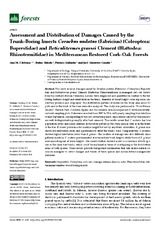Assessment and Distribution of Damages Caused by the Trunk-Boring Insects Coraebus undatus (Fabricius) (Coleoptera: Buprestidae) and Reticulitermes grassei Clément (Blattodea: Rhinotermitidae) in Mediterranean Restored Cork-Oak Forests
Autor
Cárdenas, Ana M.
Toledo, Dafne
Gallardo de la Torre, Patricia
Guerrero Casado, José
Editor
MDPIFecha
2021Materia
BuprestidsColeoptera
Cork oak
Damage
Dehesas
Quercus suber
Rhinotermitidae
Subterranean termites
Wood boring insects
METS:
Mostrar el registro METSPREMIS:
Mostrar el registro PREMISMetadatos
Mostrar el registro completo del ítemResumen
This work assesses damage caused by Coraebus undatus (Fabricius) (Coleoptera: Buprestidae) and Reticulitermes grassei Clément (Blattodea: Rhinotermitidae) in managed cork oak forests from the southern Iberian Peninsula. Lesions were diagnosed and quantified in relation to the following features: height and orientation in the trunk, diameter at breast height, solar exposure, understory presence and orography. The distribution patterns of lesions in the study area across 12 plots and in the trunk of the trees were also analyzed. The study was performed in “Sa de Hornachuelos” Natural Park (Córdoba, Spain) and the research area encompassed 12 environmentally-restored sampling plots. Data were recorded from 2007 to 2014, with yearly sampling from late June to mid-September, corresponding to the cork extraction period, since lesions caused by these insects are well distinguishable promptly after bark removal. The results reveal that C. undatus has low population levels and a non-uniform distribution pattern in the study area as well as in the trunk of the tree. It shows preference for medium height but not by any trunk orientation. R. grassei also shows low infestation levels and a preference to affect the trunk’s base. Comparatively, C. undatus showed higher infestation levels than R. grassei. The location of damage was also different, since galleries made by C. undatus predominated at intermediate trunk heights while those of R. grassei were more frequent at lower heights. Our results further showed a low co-occurrence of both species in the same tree trunks, which could be explained in terms of overlapping in the distribution areas of both species. These results provide background information that will enable natural resources managers to detect changes and trends of these species and inform future management decisions.

